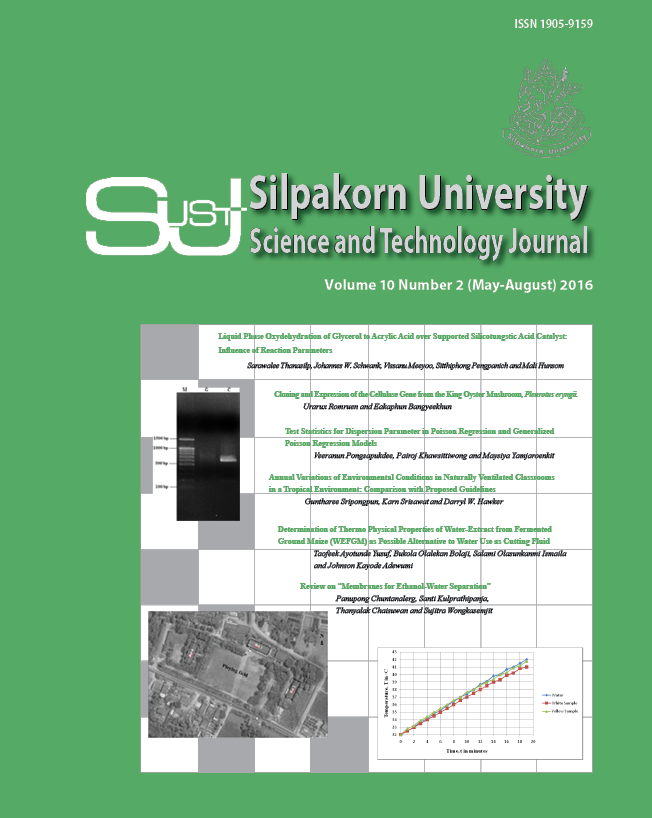Determination of Thermo Physical Properties of Water-Extract from Fermented Ground Maize (WEFGM) as Possible Alternative to Water Use as Cutting Fluid
Main Article Content
Abstract
Water has so far been regarded as the best cutting fluid but its corrosion-influence on the work piece has necessitated searching for an alternative. Meanwhile, water-extract from fermented ground maize (WEFGM) processed from two (western yellow and kewesoke white) maize varieties have been considered having been previously found to contain corrosion inhibitors. Its density, viscosity and specific heat capacity (SHC) were determined and compared with that of water. The results showed that white and yellow WEFGM give densities with percentage decrease of 0.1 and 1.0% relative to water respectively. Using Stokes’s law, the ratios of the viscosities for white WEFGM, yellow WEFGM and water were 1.22: 1.17: 1.00 and 1.20: 1.26: 1.00 respectively for the smallest (diameter of 0.45 cm) and biggest (diameter of 1.4 cm) spheres. T-test shows that there is no significant difference in the densities and viscosities values of all the samples (P<0.05). The result of SHC gives the ratio of 1.16:1.03:1.00 respectively for white, yellow and water samples with white and yellow having higher SHC than water with a difference of 15.7 and 3.6% respectively. Higher thermal capacity, presence of corrosion inhibitors with density and viscosity not quite dissimilar, viewed holistically, makes WEFGM having a better prospect than water as cutting fluid.
Downloads
Article Details
References
Akingbala, J. O., Rooney, L. W., and Faubion, J. (1981). A laboratory procedure for the preparation of ogi, a nigerian fermented food. Journal of Food Science, 46(5): 1523-1526.
Astakhov, V. P. (2001). Cutting fluids (coolants) and their application in deep-hole machining, Pp 1-17. [Online URL:https://viktorastakhov.tripod.com/DH/coolant.pdf] accessed on October 23, 2015.
Bartz, W. J. (2001) Ecological and environmental aspects of cutting fluids. Lubrication Engineering, 57(3): 13-16.
Brinksmeier, E., Walter, A., Janssen, R., and Diersen, P. (1999). Aspects of cooling application reduction in machining advanced materials. Proceedings of the Institution of Mechanical Engineers, 213: 769-778.
Byrne, G. and Scholta, E. (1993). Environmentally clean machining process – a strategic approach. CIRP Annals - Manufacturing Technology, 42(1): 471-474.
Cecil, M. D., Rao, K. V. C., Walter, W.O., and John, W.S. (1996). Effect of cutting fluid properties and applicationvariable on heat transfer in turning and boring operation, Japan/USA symposium on flexibleautomation. ASME Publications, 2: 1124-1125.
Efeovbokhan, V. E., and Ohiozua, O. N. (2013). Comparison of the cooling effects of a locally formulated car radiator coolant with water and a commercial coolant. The International Journal of Engineering and Science, 2(1): 254-262
Hill, E. C. (1983) Microbial aspects of health hazards from water-based metal working fluid. Tribology International, 16(3): 136-140.
Howes, T. D., Toenshoff, H. K., and Heur, W. (1991). Environmental aspects of grinding fluids. CIRP Annals - Manufacturing Technology, 40(2): 623-630.
Inasaki, I., Toenshoff, H. K., and Howes, T. D. (1993). Abrasive machining in the future. CIRP Annals - Manufacturing Technology, 42(2): 723-732.
Kobbekaduwa, K. P. V. B., and Wijayaratna, W. M. K. P. (2012) Data acquisition system for a falling-sphereviscometer. Proceedings of the Technical Sessions. Institute of Physics – Sri Lanka 28: 45-53.
Kothandaraman C. P., and Rudramoorthy, R. (2007). Fluid Mechanics and Machinery, 2nd ed., New Age International (P) Limited Publishers, pp 1-13.
Kumar, J. P. K. (2002). Measurement of specific heat of water. Experiment 325s.Kamaljeeth Instrumentation and Service Unit, Tata Nagar, Bengaluru-560 092, India, pp 1-7.
Machado, A. R. and Wallbank, J. (1997). The effect of extremely low lubricant volumes in machining. Wear210: 76-82.
McCoy, J. S. (1994). Introduction: tracing the historical development of metalworking fluids. In Metalworking Fluids (JP Byers, ed.), pp. 1-23.New York: Marcel Dekker.
Omemu, A. M. (2011). Fermentation dynamics during production of Ogi, a Nigerian fermented cereal porridge. Report and Opinion 3(4). [Online URL: https://www.sciencepub.net/report].
Osungbaro, T. O. (2009). Physical and nutritive properties of fermented cereal foods. African Journal of Food Science, 3(2): 023-027.
Schey, J. A. (1970). Metal Deformation Processes: Friction and Lubrication, New York: Marcel Dekker Inc.
Shah, Q. H. and Abakr, Y. A. (2007). A comparison of energy absorbing capabilities of paper and steel structures subjected to progressive failure under free falling objects. Journal of Engineering Science and Technology, 2(2): 200–210.
Shaji, S. and Radhakrishnan, V. (2003). A study on calcium fluoride as asolid lubricant in grinding.International Journal of Environmentally Conscious Design & Manufacturing, 11(1): 29-36.
Shearer, S. A. and Hudson, J. R. (2002). Fluid mechanics:stokes’ law and viscosity. Measurement Laboratory Investigation No.3. [Online URL: https://isites.harvard. edu/fs/docs/icb.topic1032465.files/Final%20Projects/Fluids%20Drag/stokes%20lab.pdf] accessed on November 25, 2015.
Viswanath, D. S., Ghosh, T., Prasad, D. H. L., Dutt, N. V. K., and Rani, K. Y. (2007). Viscosity of liquids: theory, estimation, experiment, and data. Springer Publications, Dordrecht, the Netherlands, pp 9-107.
Yusuf, T. A., Gundu, D. T., Oseni, M. I., Bolaji, B. O., and Ismaila, S.O. (2013). Evaluation of corn water for corrosion inhibitors extract. International Journal of Engineering and Science, 2(8): 31-35. [Online URL: www.theijes.com/papers/v2-i8/part.3/f0283031035.pdf] accessed on November 25, 2015.

